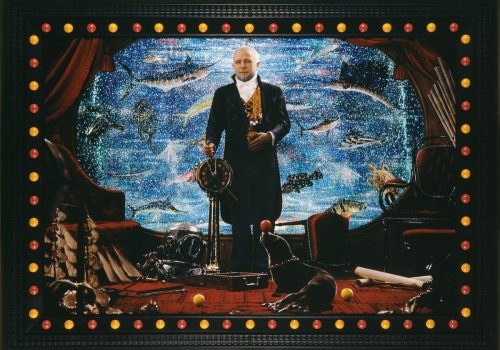André Steiner, Man Ray, Jean Painlevé… there are numerous photographers who immortalized the ocean, whether from a distance or up-close. An exhibition in Le Havre, France, allows us to discover this facet of their work alongside paintings and sculptures on the same theme.
The relationship between the depths of the ocean and photography go back to the work of Anna Atkins in 1845. The photographer did not take any underwater images since, at the time, waterproof casing had not been invented yet. But she wanted to capture what came out of the ocean, what was spewed out by the waves, namely seaweed. In order to do that, she used the cyanotype process, that is, placed a seaweed branch directly on paper then exposed it to the sun throughout the day, before lifting the branch to find in its place the shape traced in white. Her moving photographs of an element from as yet unknown world inspired followers to continue the exploration.
In 1893, a revolution took place in this area. Following five years of trial-and-error and research, the biologist Louis Boutan produced the first waterproof case, which could house a camera, allowing him to dive with it. Encouraged by his success, Boutan photographed anemones and even had fun photographing himself in his diving suit.
Fifty years later, Philippe Halsman similarly played with a waterproof camera. Accompanied by his friend Jean Painlevé, he was part of a group of amateur divers, nicknamed “the underwater club,” who indulged in silly portraits: two men enjoying appetizers, another biking, all that at the bottom of a swimming pool.
“Convulsive beauty”
Water soon became a fashionable theme. For the surrealists, it symbolized exploration of the five senses and the idea of the unconscious. The enigmatic world of the ocean deep reflected the obscure part of the human brain. Water is, in the first place, the matter of desire. From it emerged Venus, the goddess of love. In the 1930s, photographers were fascinated by this theme. Rogi André captured the sensuous movement of a nymph who seems to wed the languorous roll of a wave. Man Ray photographed a female figure filtered through an aquarium. Brassaï made small sculptures of mermaids, while Serge de Sazo did portraits of two nude female bathers. Anything goes since André Breton’s 1934 essay on “convulsive beauty” published in the magazine Minotaur. The poet had joined the photographers in doing anything and everything, as long as the driving force was search for beauty.
The tentacle
The sea, however, is not just a soft pool where nymphs, mermaids, and other water sprites come to splash around. It is also home to monsters, contorted and uncannily shaped creatures. One photographer excelled in this domain: Jean Painlevé. Both a filmmaker and a marine biologist, he photographed like no one else the savage beauty of sea fauna: here, the bust of a seahorse, there the tentacle of an octopus, and over there a lobster’s claw. Jean Painlevé enjoyed the play of forms and deliberately imbued the whole with a sense of the uncanny. The lobster claw, for example, is placed in such a way that it brings to mind a sorcerer’s crooked nose. On occasion, Jean Painlevé would take the observation of details to the extreme: he would photograph the “reproductive pouch of a seahorse” or “the respiratory plume of a fan worm.”
New landscapes
These scientific experiments — Jean Painlevé photographed most of the marine creatures in an aquarium in order to be able to use optimal lighting — find their counterpart in photographic experimentation. Jacques André Boiffard, Raoul Ubac, and André Steiner attempted to foreground the very material of the photographic film. Through the use of the photogram they discovered a new territory, a bizarre microcosm reminiscent of deep-sea motifs. This is true of the photograph by Boiffard which brings to mind the tentacle of an octopus or the image suggestive of the jagged outline of a seahorse.
The work of one contemporary photographer who searched for such forms underwater is shown at the end of the exhibition. Nicolas Floc’h immortalizes the seabed as it is today. A professional diver, he uncovers surprising tableaus, which emerge from the ocean depths. We find him strolling through a forest of giant algae off the island of Ushant or among the coral reefs sustained by the ocean current Kuroshio in Japan. At a time when the oceans are more polluted than ever, and yet still underexplored and filled with wonder, he brings to the surface novel landscapes, lively and colorful even while barren and endangered.
Jean-Baptiste Gauvin
Jean-Baptiste Gauvin is a Paris-based journalist, author, and stage director.
Ocean Imaginings
May 5 to September 9, 2018
The André Malraux Museum of Modern Art
2 Boulevard Clemenceau
76600 Le Havre
France
















